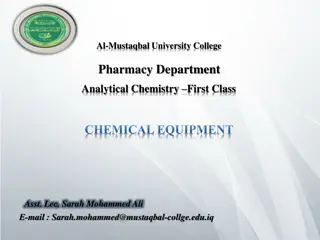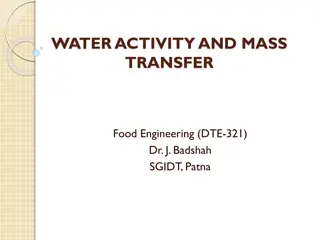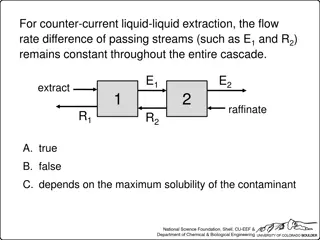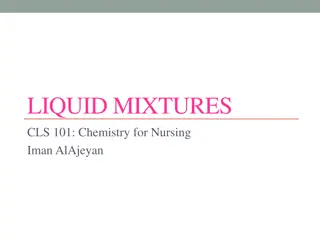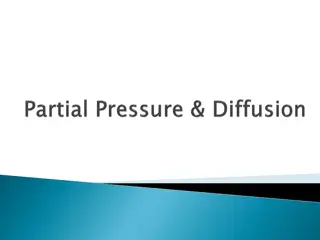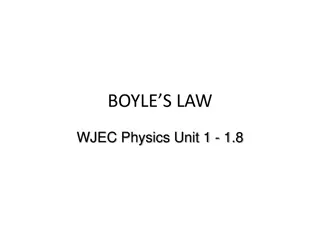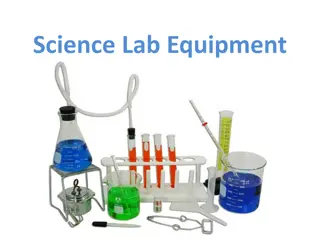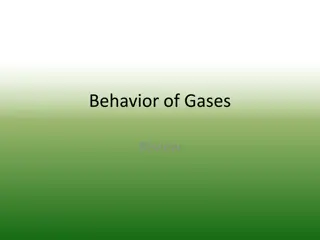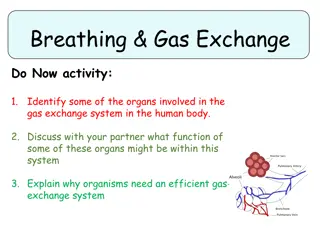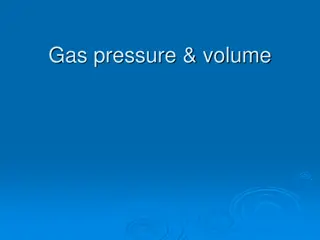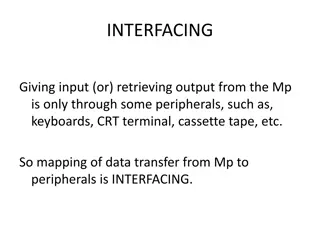Gas-Liquid Equipment in Mass Transfer Operations
Gas-liquid operations play a crucial role in mass transfer processes by facilitating intimate contact between the two fluids for efficient interphase diffusion. Various equipment such as sparged vessels (bubble columns) and mechanically agitated vessels are used to disperse gas or liquid phases, promoting mass transfer through increased interfacial surface area and dispersion. Impellers, including propellers and turbines, enhance mixing and suspension for improved mass transfer efficiency. Vortex formation is a common concern in mechanically agitated vessels, highlighting the importance of proper design and operation to prevent unwanted turbulence. Gas-liquid equipment is essential for achieving effective mass transfer rates in chemical engineering applications.
- Gas-Liquid Equipment
- Mass Transfer
- Chemical Engineering
- Interfacial Diffusion
- Equipment Classification
Download Presentation

Please find below an Image/Link to download the presentation.
The content on the website is provided AS IS for your information and personal use only. It may not be sold, licensed, or shared on other websites without obtaining consent from the author. Download presentation by click this link. If you encounter any issues during the download, it is possible that the publisher has removed the file from their server.
E N D
Presentation Transcript
(Prof.) D.K.MEHTA, ASSISTANT PROFESSOR, CHEMICAL ENGINEERING DEPARTMENT, L.E.COLLEGE-MORBI
TOPIC:- Equipments _ Gas dispersed SUBJECT:-Mass Transfer Operation-I SUBJECT CODE:-3150501
Introduction The purpose of the equipment used for the gas-liquid operations is to provide intimate contact of the two fluids in order to permit interphase diffusion of the components. The rate of mass transfer is directly dependent upon the interfacial surface exposed between the phases, and the nature and degree of dispersion of one fluid in the other are therefore of prime importance. The equipment can be broadly classified according to whether its principal action is to disperse the gas or the liquid, although in many devices both phases become dispersed.
Sparged vessels (Bubble Columns) A sparger is a device for introducing a stream of gas in the form of small bubbles into a liquid. If the vessel diameter is small, the sparger, located at the bottom of the vessel. For larger diameter, several orifices used to introduce the gas to ensure better gas distribution. Purpose of sparging is contact of sparged gas with liquid and also it can provide agitation
Mechanically agitated vessels Mechanical agitation of a liquid, usually by a rotating device, is especially suitable for dispersing solids, liquids, or gases into liquids, and it is used for many of the mass-transfer operations. Agitators can produce very high turbulence intensities which not only produce good mass- transfer coefficients but also necessary for effective dispersion of liquids and gases.
Impellers Impellers are usually mounted on an axially arranged , motor-driven shaft. The marine-type propeller is operated at relatively high speed, particularly in low-viscosity liquids. Propellers are more frequently used for liquid blending operations than for mass-transfer purposes. Turbines are frequently used for mass-transfer operations. The curved blade design is useful for suspension of fragile pulps, crystals whereas pitched-blade turbine is used for blending liquids.
Tray towers Tray towers are vertical cylinders in which the liquid and gas are contacted on trays. The liquid enters at the top and flows downward by gravity. It flows across each tray and through a downspout to the tray below. The gas passes upward through openings of one sort or another in the tray, then bubbles through the liquid to form a froth, disengages from the froth, and passes on to the tray above. Each tray on tower is a stage, since on the tray the fluids are brought into intimate contact, interphase diffusion occurs, and the fluids are separated.
Tray towers The number of equilibrium stages in a tower is dependent only upon the difficulty of the separation to be carried out. The tray efficiency and number of real tray is determined by the mechanical design used and the conditions of operation. Diameter of the tower depends upon the quantities of liquid and gas flowing through the tower per unit time.
How high tray efficiency can be achieved? For high tray efficiencies , time of contact should be long to permit the diffusion to occur, the interfacial surface between phases must be made large, and a relatively high intensity of turbulence is required to obtain high mass transfer coefficient. To achieve this deep pools of liquid and relatively high gas velocities required.
Operational difficulties to achieve high tray efficiency (1) Entrainment : At high gas velocities, when the gas is disengaged from the froth, small droplets of liquid will be carried by the gas to the tray above. This reduces the concentration change brought about by the mass transfer and reduces tray efficiency. Thus gas velocity is limited by reduction of tray efficiency due to liquid entrainment.
Operational difficulties to achieve high tray efficiency (2) Flooding- Great liquid depths on trays and high gas velocities lead to high pressure drop. Due to this, liquid leaving a tray of low pressure and enters in a tray of high pressure This results in elevated position in downspout. As the pressure drop increases because of rise in flow rate of either of liquid or gas, the level in the downspout will rise. Ultimately liquid may reach to the tray above. If further pressure drop increases liquid will fill entire space between trays. The tower is then flooded, the tray efficiency falls to low value, the flow of gas is erratic, the liquid may be forced out of the exit pipe at the top of the tower.
Operational difficulties to achieve high tray efficiency (3) Priming:- For liquid-gas combination which tend to foam excessively, high gas velocities may lead to a condition of priming. Here foam persists throughout the space between trays, and a great deal of liquid is carried by the gas from one tray to the tray above. This is an exaggerated condition of entrainment.
Operational difficulties to achieve high tray efficiency (4) Coning:- If the liquid rates are too low, the gas rising through the openings of the tray may push the liquid away and contact of the gas and liquid is poor. (5) Weeping:- If the gas rate is too low, much of the liquid may rain down through the openings of the tray, thus failing to obtain the benefit of complete flow over the trays. (6) Dumping:- At very low gas rates, none of the liquid reaches to the downspouts.
Construction of Tray tower: Tray The trays are usually made of sheet metals, of special alloys if necessary, the thickness governed by the anticipated corrosion rate. Tray spacing is usually chosen on the basis of expediency in construction, maintenance, and cost and it must be adequate against flooding and excessive entrainment. The tower diameter and consequently cross sectional area must be large to handle the gas and liquid rates within the range of satisfactory operation. The tower diameter required may be decreased by increasing tray spacing. Thus tower cost, which depends on tower height and diameter, passes through a minimum at some optimum tray spacing.
Construction of Tray tower : Shell Tower is made of Metal, glass, glass-lined metal, impervious carbon, plastic and wood depending upon the corrosion conditions but most frequently metals are used and for metals , the shells are usually cylindrical. For cleaning, small diameter towers are fitted with hand holes, large towers with manways about every tenth tray.
Construction of Tray tower The liquid is led from one tray to the next by means of downspouts or downcomers. Since the liquid is agitated into a froth on the tray, adequate residence time must be allowed in the downcomer to permit disengaging the gas from the liquid so that only clear liquid enters the tray below. The depth of liquid on the tray required for gas contacting is maintained by an overflow weir, which may or may not be a continuation of the downcomer plate.
Bubble Cap tray On these chimneys or risers lead the gas through the tray and underneath caps surmounting the risers. A series of slots is cut into the rim or skirt of each cap, and the gas passes through them to contact the liquid which flows past the caps. The liquid depth is such that the caps are covered. They offer distinct advantage of being able to handle very wide ranges of liquid and gas flow rates satisfactorily The design rate to minimum rate is called turndown ratio. They have been abandoned for new installations because of their cost which is roughly double than other trays
Sieve tray The main part of the tray is a horizontal sheet of perforated metal, across which the liquid flows, with the gas passing upward through perforations. The gas is dispersed by the perforations, expands the liquid into a turbulent froth, characterized by a very large interfacial surface for mass transfer. The trays are subject to flooding because of backup of liquid in the downcomer or priming.
Valve trays These are sieve tray with large variable opening for gas flow. The perforations are covered with movable caps which rise as the flow rate of gas increases. At low gas rates, small openings reduces tendency to weep. At high gas rates, the gas pressure drop remains low but not as low as that for sieve trays.




